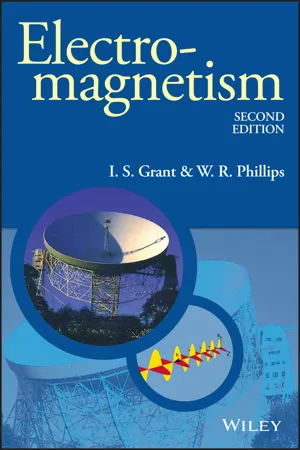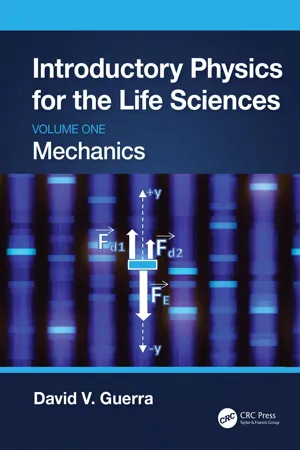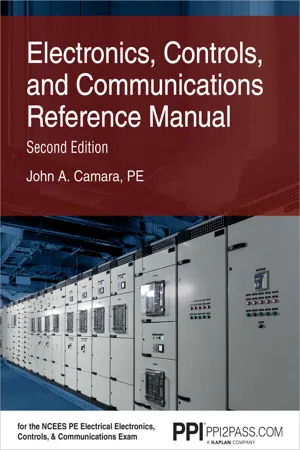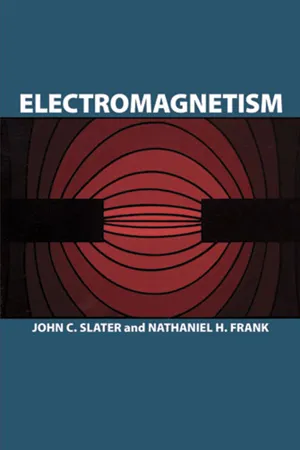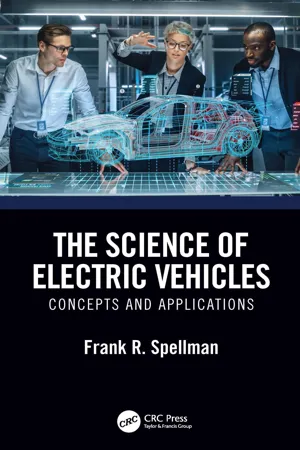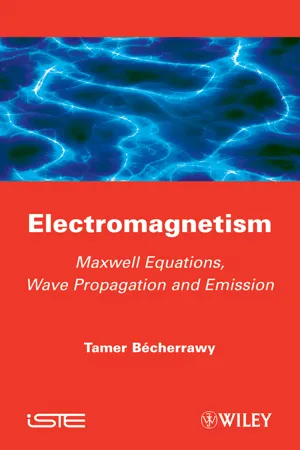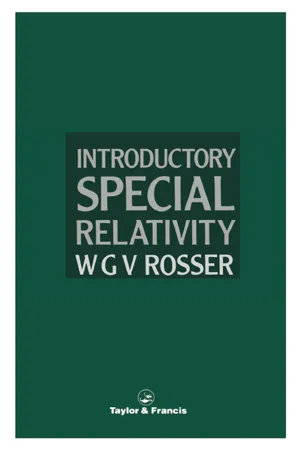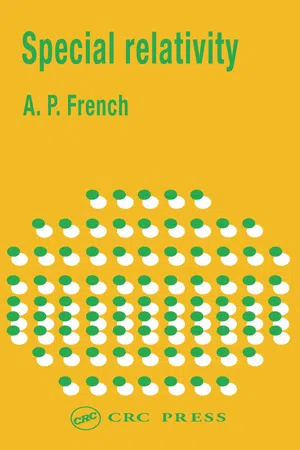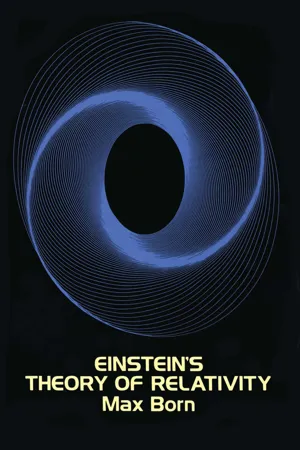Physics
Force on a Conductor
When a current-carrying conductor is placed in a magnetic field, a force is exerted on the conductor. This force is perpendicular to both the direction of the current and the magnetic field. The magnitude of the force can be calculated using the right-hand rule and is the basis for the operation of electric motors and generators.
Written by Perlego with AI-assistance
Related key terms
Related key terms
1 of 4
Related key terms
1 of 3
11 Key excerpts on "Force on a Conductor"
- eBook - ePub
- I. S. Grant, W. R. Phillips(Authors)
- 2013(Publication Date)
- Wiley(Publisher)
CHAPTER 4
Steady currents and magnetic fields
The previous chapters were concerned with the forces between stationary charges and their description in terms of the electrostatic field and potential. We now consider what happens when charges are in motion. As well as the force represented by the electric field, a moving charge may experience an additional force, called a magnetic force, when it is in the presence of other moving charges or permanent magnets. Magnetic forces are also conveniently described in terms of a vector field—the magnetic field—from which we can derive the force on a moving charge at any point.A steady electric current in a conducting wire arises from the continuous motion of charge along the wire, and a moving charge near a current-carrying wire may therefore experience a magnetic force. In this chapter we shall first explain the rules governing the flow of current in conductors, and then go on to discuss the magnetic fields caused by steady currents in conductors.4.1 ELECTROMOTIVE FORCE AND CONDUCTION
4.1.1 Current and resistance
Some of the electrons inside conductors are not bound to particular atoms but are free to move from atom to atom. In a metal we may picture these free electrons, the conduction electrons, as behaving more or less like gas molecules in a box, moving about at random with large speeds, and colliding with atoms in the metallic lattice. In the absence of an applied electric field the mean electron velocity, averaged over any volume which is very large on a microscopic scale, will be zero. If an electric field E is maintained in the conductor the electrons acquire an average velocity v in the direction opposite to the field. This is because, between collisions with atoms in the conductor, the electrons are acted upon by a force – e E. The mean drift velocity v - eBook - ePub
- Jo Verhaevert(Author)
- 2024(Publication Date)
- Routledge(Publisher)
Figure 5.12 (b). Also, since the lines of flux tend to act as if elastic, they will try to straighten themselves. This results in a force being exerted on the conductor, in the direction shown.Figure 5.12 Force on a current-carrying conductorThe direction of this force may be more simply obtained by applying Fleming’s left-hand rule. This rule is similar to the right-hand rule. The major difference is of course that the fingers and thumb of the left hand are now used. In this case, the F irst finger indicates the direction of the main F lux (from the poles). The seC ond finger indicates the direction of C urrent flow. The thuM b shows the direction of the resulting force and hence consequent M otion. This is shown in Figure 5.13.Figure 5.13 Fleming’s left-hand rule: the cubeSimple experiments can be used to confirm that the force exerted on the conductor is directly proportional to the flux density produced by the pole pieces, the value of current flowing through the conductor and the length of conductor lying inside the field. This yields the following equation for the force F, expressed in newton or N:F = B I l(5.4) The determination of the effective lengthof the conductor is exactly the same as that for the generator principle previously considered. So any conductor extending beyond the main field does not contribute to the force exerted. Equation (5.4) also only applies to the condition when the conductor is perpendicular to the main flux. If it lies at some angle less than 90°, then the force exerted on it will be reduced. Thus, in general, the force exerted is given bylF = B I l sin θ(5.5) Worked Example 5.7 Q A conductor of effective length 22 cm lies at right angles to a magnetic field of density 0.35 T. Calculate the force exerted on the conductor when carrying a current of 3 A.l = 0.22 m ; B = 0.35 T ; I = 3 A ; θ =90∘F = B I l s i n θ = 0.35 × 3 × 0.22 × 1 = 0.231 NWorked Example 5.8Q A pair of pole pieces 5 cm by 3 cm produce a flux of 2.5 mWb. A conductor is placed in this field with its length parallel to the longer dimension of the poles. When a current is passed through the conductor, a force of 1.25 N is exerted on it. Determine the value of the current. If the conductor was placed at 45° to the field, what then would be the force exerted? - David V. Guerra(Author)
- 2023(Publication Date)
- CRC Press(Publisher)
) . Thus, it is electrical currents that “feel” magnetic forces.6.3.2 Example of Computing a Magnetic Force on a Current-Carrying Wire
Compute the magnitude and direction of the force on a 12 cm long wire carrying 3.0 A of current in the +x-direction in a region with a constant magnetic field of 4.0 × 10−7 T in the +z-direction.Solution:- Step 1: As shown in Figure 6.10 , sketch the diagram paying close attention to the directions of the current and the magnetic field.
The dots represent the magnetic field coming out of the page in the +z-direction and the current is moving to the right in the +x-direction.FIGURE 6.10 Example of the magnetic force on a current-carrying wire.
- Step 2: Compute the magnitude of the magnetic force on the current-carrying wire with equation (6.2),
F = B I L s i n ( θ )F = B I L sin( θ )=(4.0 ×)10T− 7(3.0 A)(= 1.4 ×12 m)10N− 7
- Step 3: Use the RHR to find the direction of the magnetic force on the current-carrying wire and draw the force vector on the diagram. Notice that the x- and z-components of the force are zero and the magnetic force on the current-carrying wire is in the –y-direction.
F x= 0 ,F y= − 1.4 ×10N ,− 7F z= 0
6.4 Magnetic Force on a Moving Charged Particle
As demonstrated in Figure 6.11 , an electrical current can be thought of as the flow of electrical charge moving through a wire. If this wire is in a magnetic field, the force due to the magnetic field can be thought of as acting on the individual charges moving at a given speed.FIGURE 6.11 Positively charged particle moving through a wire in a magnetic field.Given that the force due the magnetic field isF = B I L sin ( θ )and the electrical current is the flow rate of electric charge,I =Δ qΔ t- John A. Camara(Author)
- 2019(Publication Date)
- PPI, a Kaplan Company(Publisher)
16.49 . In electrical engineering practice the velocities of electrons are much less than the velocity of light, therefore the magnetic force is much weaker than the electric force. Additionally, the speed of light squared is fundamentally related to magnetic permeability and the electric permittivity as follows.16.50Finally, the magnetic force can be viewed as the electric force multiplied by the factor. That is, the magnetic force is a result of charges in relative motion.16.51The magnetic and electric forces on two reference charges moving in parallel are shown inFig. 16.14.Figure 16.14Magnetic and Electric Forces on Moving ChargesMagnetic SuperpositionMagnetic forces occur as a result of the interaction of a pair of current-carrying conductors or the equivalent. One sets up the magnetic field and the other exhibits a force reaction to this same magnetic field. In free space and most nonmagnetic materials, the magnitude of the magnetic field is proportional to the total current that sets up the field as long as the permeability of the medium is constant. However, this is not true for iron and other ferromagnetic materials. Therefore, in general, the principle of linear superposition does not apply to current-carrying conductors in the vicinity of ferromagnetic materials.24. Magnetic FieldsA magnetic field is a region in which a moving electric charge exerts a measurable force on another moving charge. It is a vector force field because a moving test charge placed in the field will experience a force in a given direction and with a specific magnitude. The direction of the field is along the flux lines, which are perpendicular to the current (that is, the moving charges creating the magnetic field). These lines, ideally, represent the direction of the force exerted on an infinitely small, isolated positive test charge moving with speed v. The actual direction is represented by the unit vector a .Equation 16.52represents the strength of the B-field , or the magnetic flux density , in a substance with permeability μ at a distance r from current element d l 1 that gives the direction of one turn, N , of the total current, I .24 The denominator, 4πr 2 , represents the surface area of a sphere centered on the current element d l whose surface just touches the point in space where the B -field is being evaluated. Specific configurations may be evaluated withEq. 16.52by changing B to d B and l to d l- eBook - ePub
- John C. Slater, Nathaniel H. Frank(Authors)
- 2012(Publication Date)
- Dover Publications(Publisher)
Probably part of the trouble with these theories is the fact that new phenomena are appearing as we go to very rapid particles of very high energy, which complicate the whole theory. These are the phenomena of the forces between the particles, neutrons and protons, in the nucleus. There is good evidence that these forces are not electromagnetic, but of another variety, produced not by the electromagnetic field, but by a meson field. This field has been described mathematically by analogy with electromagnetic theory. It similarly has a wave aspect, but also a corpuscular aspect, the corpuscles in this case being mesons, rather than photons. It is thus becoming likely that there exist in nature a number of different levels of forces and particles: the electromagnetic field and the photons, the electrons and protons and neutrons and their associated fields of the de Broglie or Schrödinger type, and the mesons and their fields. And the guiding pattern for the development of all these theories is at present the electromagnetic theory in its classical form. It remains to be seen what final synthesis of these various theories can eventually be made.We are now ready to proceed with our study of classical electromagnetic theory, which alone we shall take up in this volume. We start in the historical order, treating electrostatics, first from the basis of Coulomb’s law, then from the standpoint of field theory, showing as Faraday did how much that helps us in the study of problems involving dielectrics and conductors. Then we take up in a similar way the magnetic field, passing on through the study of electromagnetic induction to Maxwell’s equations, and to their application to the electromagnetic theory of light and of other electromagnetic radiation fields.1. The Force on a Charge. —Electromagnetic theory deals with the forces acting on charges and currents. We find that an electric charge at a given point of space is acted on by two types of force: an electric force, independent of its velocity, and a magnetic force, proportional to its velocity (that is, to the current carried by the charge), and at right angles to its velocity. We find that different charges at the same point of space are acted on by different amounts of force, and we arbitrarily define the strength of the charge as being proportional to the magnitude of force acting on it in a given field. We shall see later how to define the unit of charge, the coulomb. We can define two vectors at every point of space, E the electric intensity, B the magnetic induction, such that the force F on a charge of q coulombs moving with velocity v - eBook - ePub
The Science of Electric Vehicles
Concepts and Applications
- Frank R. Spellman(Author)
- 2023(Publication Date)
- CRC Press(Publisher)
In Figure 3.15, a wire is passed through a piece of cardboard and connected through a switch to a dry cell. With the switch open (no current flowing), if we sprinkle iron filings on the cardboard then tap it gently, the filings will fall back haphazardly. Now, if we close the switch, current will begin to flow in the wire. If we tap the cardboard again, the magnetic effect of the current in the wire will cause the filings to fall back into a definite pattern of concentric circles with the wire as the center of the circles. Every section of the wire has this field of force around it in a plane perpendicular to the wire, as shown in Figure 3.16. FIGURE 3.15 A circular pattern of magnetic force exists around a wire carrying an electric current. The ability of the magnetic field to attract bits of iron depends on the number of lines of force present. The strength of the magnetic field around a wire carrying a current depends on the current, since it is the current that produces the field. The greater the current, the greater the strength of the field. A large current will produce many lines of force extending far from the wire, while a small current will produce only a few lines close to the wire, as shown in Figure 3.17. FIGURE 3.16 The circular fields of force around a wire carrying a current are in planes which are perpendicular to the wire. FIGURE 3.17 The strength of the magnetic field around a wire carrying a current depends on the amount of current. Polarity of a Single Conductor The relation between the direction of the magnetic lines of force around a conductor and the direction of current flow along the conductor may be determined by means of the left-hand rule for a conductor. If the conductor is grasped in the left hand with the thumb extended in the direction of electron flow (− to +), the fingers will point in the direction of the magnetic lines of force - eBook - ePub
Electromagnetism
Maxwell Equations, Wave Propagation and Emission
- Tamer Becherrawy(Author)
- 2013(Publication Date)
- Wiley-ISTE(Publisher)
electrostatic pressure[3.32]This pressure tends to increase the volume of the conductor. It is numerically equal to the density of electrostatic energy just outside the surface.3.6. Currents and current densities
An electric current is an ordered flow of charged particles. It may be of three types: a beam of charged particles moving in vacuum (electrons, protons, alpha particles, etc.), a conduction current in solid conductors and solutions, and a convection current produced by moving bodies carrying charges. In this chapter we consider mostly the conduction currents in solids. Electric currents have some physical and chemical effects and they transport energy and signals. The motion of charged particles is always impeded by friction forces, which dissipate energy and ultimately end the motion. Thus a sustained current can be established only if a generator acts on the charges and supplies them with energy.If an average electric charge δQ traverses a surface S in the time interval δt (Figure 3.10a ), we say that the current intensity (in amperes) through S is[3.33]If a charge δq moves from a point A to a point B with a potential drop VAB ≡ VA −VB , the charge loses electric potential energy δq VAB . This energy is supplied to the circuit between A and B. It may be stored as electric energy in a capacitor or as magnetic energy in a coil, dissipated as heat in a resistor, transformed to mechanical energy or chemical energy, etc. If no generator exists between these points and the electric current flows from higher to lower potential, it supplies energy. The total energy in a circuit is obviously supplied by the generators. In the case of a continuous current I, the charge passing during δt is δq = I δt and the energy supplied by the charge dq between A and B is dWAB = dq VAB = IVAB dt - eBook - ePub
- W G V Rosser(Author)
- 2017(Publication Date)
- CRC Press(Publisher)
The resultant force per unit length on wire 2 is given byf y=f elec+f max=−λ 22 π ∈0r=μ 0λ 2υ 22 πrλ 22 π ∈0r(.1 −)μ 0∈0υ 2(8.4) Numerical substitution of 8.85 × 10−12 F m−1 for ∈0 and 4π × 10−7 H m−1 for μ0 shows that μ0 ∈0 = 1/c2 , where c = 3 × 108 m s−1 is the velocity of light in empty space. Hence the resultant force, electric plus magnetic, on unit length of wire 2 isf y=λ 22 π ∈0r(.1 −)υ 2/c 2(8.5) In this simple case, the ratio of the magnetic force to the electric force is υ2 /c2 , where υ is the velocity of the charges relative to ∑, the inertial reference frame chosen. This illustrates that magnetic forces are of second order in υ/c.Consider a typical case, say a conduction current of 1 A flowing in a copper wire of cross-sectional area, a = 1 mm2 (10−6 m2 ). Let N be the number of charge carriers per unit volume (approximately 8.5 × 1028 m−3 for copper), and let q = −1.6 × 10−19 C be the charge on each electron. The current is given byI = q N a υ ,where υ is the mean drift velocity of the electrons. Substituting, we find υ ≈ 7 × 10−5 m s−1 . If the charges shown in Fig. 8.1 moved with this speed, the ratio of the magnetic to the electric forces given by equation (8.5) would be about 5 × 10−26 . Why then are the magnetic forces between electric circuits so important? In practice, in a copper conductor there is no resultant electric charge inside the conductor, since the charges on the moving electrons are compensated by the positively charged ions, which are virtually at rest in a stationary conductor, as illustrated in Fig. 8.2 . It will be assumed that the total charge per unit length due to the positive ions is λ while that due to the negative electrons is − λ in each conductor measured in the laboratory frame ∑.Fig. 8.2 Forces between two conduction currents I. In the simplified model used the positive ions are at rest and the negative electrons all move with the same uniform velocity υ - eBook - ePub
- A.P. French(Author)
- 2017(Publication Date)
- CRC Press(Publisher)
2 is moving and therefore can “feel” the magnetic field.1 This is, of course, a gross oversimplification. The conduction electrons in a wire have all sorts of speeds and directions, but v represents a steady mean drift velocity associated with the net current flow.Fig. 8-13 (a) A test charge moves parallel to a current-bearing wire. (b) The situation is transformed to a frame in which the test charge is stationary.To find out something about the magnetic force on q 2 as observed in S , let us shift to a different frame, S ′, moving with velocity v with respect to S . In S ′, q 2 is stationary, the electrons in the wire are stationary, and the positive ions are moving with velocity −v [Fig. 8-13 (b)].As before, the distance between the stationary electrons in the wire is (from the standpoint of S ′) increased and therefore their linear density λ_ is decreased by the factor 1/γ: λ_ = −λ0 /γ. On the other hand, the relativistic contraction of the distance between the moving positive ions results in an increase in their linear density λ+ by the factor γ: λ+ = γλ0 . The positive and negative charge densities as observed in this frame are no longer equal and opposite! And the difference is in the direction that results in a net force on q 2 that is an attractive force if it is an electron traveling in the same direction as the electrons in the wire.Let us now spell this out in detail. In S ′ the test-charge q 2 is stationary and the force on it, F′ , depends only on the electric field of the linear arrays of positive and negative charge. The net charge density λ′ as measured in S ′ is given by+λ+λ ′=λ - eBook - ePub
- Max Born(Author)
- 2012(Publication Date)
- Dover Publications(Publisher)
Fig. 84 ).We imagine a bundle of parallel lines of magnetic force that constitute a magnetic field H. We suppose a circular conducting wire placed around this sheath (Fig. 95 ). If the intensity of field H changes in the small interval of time by the amount H, we call its velocity of change or the change in the number of lines of force. If in analogy to the electrical displacement we represent the lines of force as chains of magnetic dipoles (which, however, according to Ampère is actually not true) then with the change of H a displacement of the magnetic quantities will occur in every ether molecule, or a “magnetic displacement current” will flow whose current strength per unit of area or current density is given by If the field H is not in the ether but in a substance of permeability the density of the magnetic displacement current is Thus the magnetic current passes through the cross-section f, that is, through the surface of the circle formed by the conducting wire.Now, according to Faraday, this magnetic current produces all around it an electric field E, which encircles the magnetic current exactly as the magnetic field H encircles the electric current in Oersted’s experiment, but in the reverse direction. It is this electric field E that drives the induced current around in the conducting wire; it is also present even if there is no conducting wire in which the current can form.We see that the magnetic induction of Faraday is a perfect parallel to the electromagnetic discovery of Oersted. The quantitative law, too, is the same. According to Biot and Savart, the magnetic field H produced by a current element of length l and of strength J (compare Fig. 84 ) in the middle plane perpendicular to the element is perpendicular to the connecting line r and to the current direction, and has the value ((formula 54 )).Exactly the same holds when electric and magnetic quantities are exchanged and when the sense of rotation is reversed (Fig. 96 ). The induced electric intensity of field in the central plane is given by - eBook - ePub
Fields of Force
The Development of a World View from Faraday to Einstein.
- William Berkson(Author)
- 2014(Publication Date)
- Routledge(Publisher)
He began by giving a precise definition of a line of magnetic force. It is a line whose tangent is always in the direction of the magnetic force at that point (that is in the direction a small magnetic needle would take at that point), or it can be considered as a line along which no electromagnetic induction takes place if a wire is moved along it. Further, the intensity of force in a region can be represented by the density of lines of force drawn through it. One could fix a ‘unit line’ of force to draw these lines, which would be varying distances apart, depending on the amount of force between them. Such lines may possibly be lines of flow of ether, lines of action at a distance or lines of vibrations. Faraday did not commit himself to any one of these views, but he did state, ‘I am more inclined to the notion that in the transmission of the force there is such an action, external to the magnet, than that the effects are merely attraction and repulsion at a distance.’ 2 In his argument, Faraday then returned to the experiments which originally convinced him of the value of the lines of force view—the unipolar induction experiments. 3 What Faraday wished to show was that the lines of force clearly and exactly represent the phenomena which occur in such experiments. First, he showed that the one rule of electromagnetic induction is that the [total] induced current is directly proportional solely to the number of lines of force cut (for a wire of given conductivity). Second, he showed that the magnetic lines of force go through the magnet itself, and so are always closed; there are no magnetic ‘poles’, but only places where the lines of force happen to enter and leave the magnet
Index pages curate the most relevant extracts from our library of academic textbooks. They’ve been created using an in-house natural language model (NLM), each adding context and meaning to key research topics.
Explore more topic indexes
Explore more topic indexes
1 of 6
Explore more topic indexes
1 of 4
